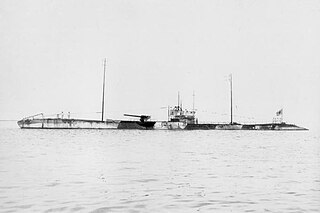SM U-83 was a Type U 81 U-boat of the German Imperial Navy during the First World War. She had been commissioned and deployed to operate off the coast of the British Isles and attack coastal shipping as part of the German U-boat campaign.

SM U-86 was a Type U 81 submarine manufactured in the Germaniawerft, Kiel shipyard for the German Empire during World War I.

SM U-90 was a Type U-87 U-boat of the Imperial German Navy during World War I. Its commander Walter Remy made regular stops at remote island North Rona for provisions such as fresh mutton. On 15 May 1918, U-90 shelled the Hirta wireless station in St Kilda, Scotland. On 31 May 1918, U-90 torpedoed and sank USS President Lincoln, a former Hamburg America Line steamer that had been seized by the United States for troop transportation. From the U.S. Navy crew that abandoned the sinking vessel, U-90 captured Lieutenant Edouard Izac, eventually taking him to Germany. Izac later escaped German captivity and reported to the US Navy about German submarine movements.
SM UC-20 was a German Type UC II minelaying submarine or U-boat in the German Imperial Navy during World War I. The U-boat was ordered on 29 August 1915 and was launched on 1 April 1916. She was commissioned into the German Imperial Navy on 7 September 1916 as SM UC-20. In 13 patrols UC-20 was credited with sinking 21 ships, either by torpedo or by mines laid. UC-20 was surrendered on 16 January 1919 and broken up at Preston in 1919–20.
SM U-82 was a Type U 81 U-boat of the Imperial German Navy during World War I.
SM U-81 was one of the 329 submarines serving in the Imperial German Navy in World War I. U-81 was engaged in naval warfare and took part in the First Battle of the Atlantic.
SM U-84 was one of the 329 submarines serving in the Imperial German Navy in World War I. U-84 was engaged in the naval warfare and took part in the First Battle of the Atlantic.
SM U-85 was one of the 329 submarines serving in the Imperial German Navy in World War I. U-85 was engaged in the naval warfare and took part in the First Battle of the Atlantic.
SM U-87 was one of the 329 submarines serving in the Imperial German Navy in World War I. U-87 was engaged in the naval warfare and took part in the First Battle of the Atlantic. She sank some 22 merchant vessels before 25 December 1917, when HMS Buttercup rammed U-87 in the Irish Sea and depth-charged her. Then the P-class sloop P.56 sank her. U-87's entire crew of 44 were lost.
SM U-88 was a Type U 87 submarine built for the Imperial German Navy in World War I. U-88 was engaged in the naval warfare and took part in the First Battle of the Atlantic.
SM U-89 was one of the 329 submarines serving in the Imperial German Navy in World War I. U-89 was engaged in the naval warfare and took part in the First Battle of the Atlantic. On 12 February 1918, U-89 was rammed and sunk by HMS Roxburgh off Malin Head. There were no survivors.
SM U-91 was one of the 329 submarines serving in the Imperial German Navy in World War I. U-91 was engaged in the naval warfare and took part in the First Battle of the Atlantic.
SM U-94 was a Type U 93 submarine and one of the 329 submarines serving in the Imperial German Navy in World War I. U-94 was engaged in the naval warfare and took part in the First Battle of the Atlantic.
SM U-97 was one of the 329 submarines serving in the Imperial German Navy in World War I. U-97 was engaged in the naval warfare and took part in the First Battle of the Atlantic. The German unit sank by accident on her way to surrender at position 53°25′N3°10′E.
SM U-98 was a Type U 93 submarine and one of the 329 submarines serving in the Imperial German Navy in World War I. U-98 was engaged in the naval warfare and took part in the First Battle of the Atlantic.
SM U-99 was one of the 329 submarines serving in the Imperial German Navy in World War I.
SM U-107 was one of the 329 submarines serving in the Imperial German Navy in World War I. U-107 was engaged in the naval warfare and took part in the First Battle of the Atlantic.

SM U-108 was a submarine in the Imperial German Navy in World War I, taking part in the First Battle of the Atlantic.

SM U-125 was one of the 329 submarines serving in the Imperial German Navy in World War I. U-125 was engaged in the naval warfare and took part in the First Battle of the Atlantic.
SM U-160 was one of the 329 submarines serving in the Imperial German Navy in World War I. U-160 was engaged in the naval warfare and took part in the First Battle of the Atlantic.



